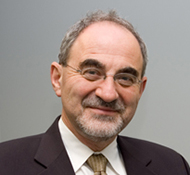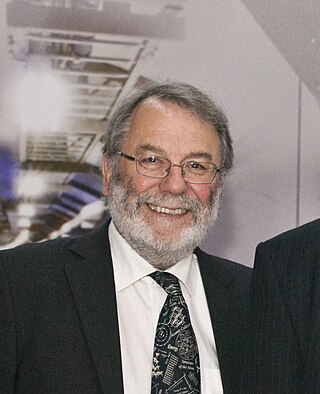Related Research Articles

Eli Yablonovitch is an American physicist and engineer who, along with Sajeev John, founded the field of photonic crystals in 1987. He and his team were the first to create a 3-dimensional structure that exhibited a full photonic bandgap, which has been named Yablonovite. In addition to pioneering photonic crystals, he was the first to recognize that a strained quantum-well laser has a significantly reduced threshold current compared to its unstrained counterpart. This is now employed in the majority of semiconductor lasers fabricated throughout the world. His seminal paper reporting inhibited spontaneous emission in photonic crystals is among the most highly cited papers in physics and engineering.

Ennackal Chandy George Sudarshan was an Indian American theoretical physicist and a professor at the University of Texas. Prof.Sudarshan has been credited with numerous contributions to the field of theoretical physics, including Glauber–Sudarshan P representation, V-A theory, tachyons, quantum Zeno effect, open quantum system and quantum master equations, spin–statistics theorem, non-invariance groups, positive maps of density matrices, and quantum computation.

Peter Zoller is a theoretical physicist from Austria. He is professor at the University of Innsbruck and works on quantum optics and quantum information and is best known for his pioneering research on quantum computing and quantum communication and for bridging quantum optics and solid state physics.

Sir Peter Leonard Knight is a British physicist, professor of quantum optics and senior research investigator at Imperial College London, and principal of the Kavli Royal Society International Centre. He is a leading academic in the field of quantum optics and is the recipient of several major awards including the Royal Medal from the Royal Society and the Thomas Young Medal and Prize from the Institute of Physics. He is a former president of the Institute of Physics and Optica, the first non North American-based person to take the position.
Narasimhaiengar Mukunda is an Indian theoretical physicist.

Joseph Henry Eberly is an American physicist who holds the positions of Andrew Carnegie Professor of Physics and Astronomy and Professor of Optics at the University of Rochester.
Ian Alexander Walmsley is Provost of Imperial College London where he is also Chair of Experimental Physics. He was previously pro-vice-chancellor for research and Hooke Professor of Experimental Physics at the University of Oxford, and a professorial fellow at St Hugh's College, Oxford. He is also director of the NQIT hub within the UK National Quantum Technology Programme, which is led by the University of Oxford. He is also a Fellow of the Institute of Physics, the American Physical Society and the Optical Society of America.
Mikhail Lukin ; born 10 October 1971) is a Russian theoretical and experimental physicist and a professor at Harvard University. He was elected a member of the National Academy of Sciences in 2018.

Jun Ye is a Chinese-American physicist at JILA, National Institute of Standards and Technology, and the University of Colorado Boulder, working primarily in the field of atomic, molecular, and optical physics.
Shaul Mukamel is a chemist and physicist, currently serving as a Distinguished Professor at the University of California, Irvine. He is known for his works in non linear optics and spectroscopy.

Anurag Sharma is an Indian physicist and a professor at the department of physics of the Indian Institute of Technology Delhi. He is known for his pioneering researches on optoelectronics and optical communications and is an elected fellow of all the three major Indian science academies viz. Indian Academy of Sciences, Indian National Science Academy and National Academy of Sciences, India as well as Indian National Academy of Engineering. The Council of Scientific and Industrial Research, the apex agency of the Government of India for scientific research, awarded him the Shanti Swarup Bhatnagar Prize for Science and Technology, one of the highest Indian science awards for his contributions to Engineering Sciences in 1998.
Shasanka Mohan Roy is an Indian quantum physicist and a Raja Ramanna fellow of the Department of Atomic Energy at the School of Physical Sciences of Jawaharlal Nehru University. He is also a former chair of the Theoretical Physics Group Committee at Tata Institute of Fundamental Research. Known for developing Exact Integral Equation on pion-pion dynamics, also called Roy's equations, and his work on Bell inequalities, Roy is an elected fellow of all the three major Indian science academies – Indian Academy of Sciences, Indian National Science Academy, and National Academy of Sciences, India – as well as The World Academy of Sciences. The Council of Scientific and Industrial Research, the apex agency of the Government of India for scientific research, awarded Roy the Shanti Swarup Bhatnagar Prize for Science and Technology, one of the highest Indian science awards, for his contributions to Physical Sciences in 1981.
Peter David Drummond is a physicist and distinguished professor in the Centre for Quantum and Optical Science at Swinburne University of Technology.
Deepak Mathur is an Indian molecular and atomic physicist and was a Distinguished Professor at the Tata Institute of Fundamental Research. He has been the J C Bose National Fellow at the Department of Atomic and Molecular Physics at Manipal Academy of Higher Education (MAHE) and founding director of the UM-DAE Centre for Excellence in Basic Science at the University of Mumbai. Known for his research on molecular and biological physics, Mathur is an elected fellow of the Indian Academy of Sciences, Indian National Science Academy and The World Academy of Sciences. The Council of Scientific and Industrial Research, the apex agency of the Government of India for scientific research, awarded him the Shanti Swarup Bhatnagar Prize for Science and Technology, one of the highest Indian science awards, for his contributions to physical sciences in 1991. Amongst other awards, he has been the Royal Society's Guest Fellow at Oxford University and winner of the European Union's Erasmus-Mundus prize in optical science which he held at Imperial College London. Currently he is an adjunct professor at MAHE and is also learning to fly. His initial training was on a Grob G-115 2-seater training aircraft but he has now moved on to flying PA-28 4-seater aircraft.
Olga Anatolevna Kocharovskaya is a distinguished professor of physics at Texas A&M University, known for her contributions to laser physics, quantum optics and gamma ray modulation.
Gattamraju Ravindra Kumar is an Indian laser physicist and a senior professor of Nuclear and Atomic Physics at Tata Institute of Fundamental Research. Known for his research on Ultrashort pulse and Warm dense matter, Kumar is an elected fellow of the Indian Academy of Sciences and the Indian National Science Academy. The Council of Scientific and Industrial Research, the apex agency of the Government of India for scientific research, awarded him the Shanti Swarup Bhatnagar Prize for Science and Technology, one of the highest Indian science awards, for his contributions to physical sciences in 2003. He is also a recipient of the B. M. Birla Science Prize and Infosys Prize.

Aditi Sen De is an Indian scientist, a professor in quantum information and computation group at the Harish-Chandra Research Institute, Prayagraj. She was born on 1 October 1974 in Kolkata, India. She is known for her research on quantum information and computation, quantum communication including quantum cryptography, quantum optics and many-body physics. The Council of Scientific and Industrial Research, the apex agency of the Government of India for scientific research, awarded her the Shanti Swarup Bhatnagar Prize for Science and Technology for her contributions to physical sciences in 2018. She is the first female physicist to be given this honour. In 2022, she was elected as a member of Indian Academy of Sciences and Indian National Science Academy.
Govind P. Agrawal is an Indian American physicist and a fellow of Optica, Life Fellow of the IEEE, and Distinguished Fellow of the Optical Society of India. He is the recipient of James C. Wyant Professorship of Optics at the Institute of Optics and a professor of physics at the University of Rochester. He is also a Distinguished scientist at the Laboratory for Laser Energetics (LLE) in the University of Rochester. Agrawal has authored and co-authored several highly cited books in the fields of non-linear fiber optics, optical communications, and semiconductor lasers.
Samarendra Nath Biswas was an Indian theoretical physicist specialized in theoretical high energy physics, particle physics and mathematical physics and is known for his work in several diverse areas.

Debabrata Goswami FInstP FRSC, is an Indian chemist and the Prof. S. Sampath Chair Professor of Chemistry, at the Indian Institute of Technology Kanpur. He is also a professor of The Department of Chemistry and The Center for Lasers & Photonics at the same Institute. Goswami is an associate editor of the open-access journal Science Advances. He is also an Academic Editor for PLOS One and PeerJ Chemistry. He has contributed to the theory of Quantum Computing as well as nonlinear optical spectroscopy. His work is documented in more than 200 research publications. He is an elected Fellow of the Royal Society of Chemistry, Fellow of the Institute of Physics, the SPIE, and The Optical Society. He is also a Senior Member of the IEEE, has been awarded a Swarnajayanti Fellowship for Chemical Sciences, and has held a Wellcome Trust Senior Research Fellowship. He is the third Indian to be awarded the International Commission for Optics Galileo Galilei Medal for excellence in optics.
References
- ↑ "Girish Agarwal | Royal Society". royalsociety.org. Retrieved 30 April 2019.
- ↑ "Awardee Details: Shanti Swarup Bhatnagar Prize". ssbprize.gov.in. 30 April 2019. Retrieved 30 April 2019.
- 1 2 3 4 5 6 7 8 9 "CV Prof. Agarwal" (PDF). Archived from the original (PDF) on 30 April 2019. Retrieved 30 April 2019.
- ↑ "Girish Agarwal - Google Scholar Citations". scholar.google.com. Retrieved 30 April 2019.
- ↑ "Quantum Optics | Cambridge University Press". Cambridge University Press. Retrieved 30 April 2019.
- ↑ "Customer Reviews (Amazon)". Amazon. 15 November 2012. Retrieved 30 April 2019.
- ↑ Agarwal, G. S. (1974), "Quantum statistical theories of spontaneous emission and their relation to other approaches", in Höhler, G. (ed.), Quantum Optics, Springer Tracts in Modern Physics, vol. 70, Springer Berlin Heidelberg, pp. 1–128, doi:10.1007/bfb0042382, ISBN 9783540379188
- ↑ "Humboldt Foundation Profile". humboldt-foundation.de. Archived from the original on 30 April 2019. Retrieved 30 April 2019.
- ↑ "Girish S. Agarwal Biography". optica.org. Retrieved 8 December 2023.
- ↑ "Agarwal, Girish Saran". TWAS. Retrieved 30 April 2019.
- ↑ "INSA :: Indian Fellow Detail". insaindia.res.in. Archived from the original on 30 April 2019. Retrieved 30 April 2019.
- ↑ "APS Fellow Archive". aps.org. Retrieved 8 December 2023.